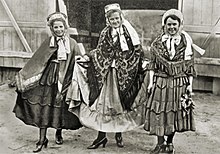
Masuria is an ethnographic and geographic region in northern and northeastern Poland, known for its 2,000 lakes. Masuria occupies much of the Masurian Lake District. Administratively, it is part of the Warmian-Masurian Voivodeship. Its biggest city, often regarded as its capital, is Ełk. The region covers a territory of some 10,000 km2 which is inhabited by approximately 500,000 people.

Warmia is both a historical and an ethnographic region in northern Poland, forming part of historical Prussia. Its historic capitals were Frombork and Lidzbark Warmiński and the largest city is Olsztyn.

Olsztyn is a city on the Łyna River in northern Poland. It is the capital of the Warmian-Masurian Voivodeship, and is a city with county rights. The population of the city was estimated at 169,793 residents in 2021.

East Prussia was a province of the Kingdom of Prussia from 1773 to 1829 and again from 1878 ; following World War I it formed part of the Weimar Republic's Free State of Prussia, until 1945. Its capital city was Königsberg. East Prussia was the main part of the region of Prussia along the southeastern Baltic Coast.
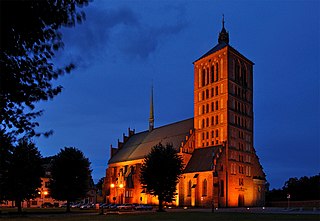
Braniewo, is a town in northern Poland, in Warmia, in the Warmian-Masurian Voivodeship, with a population of 16,907 as of June 2021. It is the capital of Braniewo County.

Warmian–Masurian Voivodeship is a voivodeship (province) in northeastern Poland. Its capital and largest city is Olsztyn. The voivodeship has an area of 24,192 km2 (9,341 sq mi) and in 2019 had a population of 1,425,967.
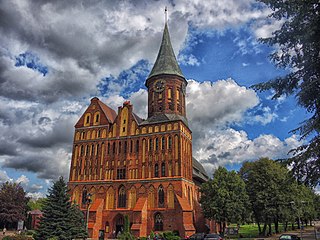
Prussia is a historical region in Central Europe on the south-eastern coast of the Baltic Sea, that ranges from the Vistula delta in the west to the end of the Curonian Spit in the east and extends inland as far as Masuria, divided between Poland, Russia and Lithuania.

Ostróda is a town in northern Poland, in the historic region of Masuria. It is the seat of the Ostróda County within the Warmian-Masurian Voivodeship and has approximately 33,191 inhabitants (2009).
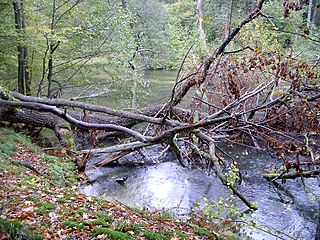
The Łyna, is a river that begins in northern Poland's Warmian-Masurian Voivodeship and ends in Russia's Kaliningrad Oblast.

Lidzbark Warmiński, often shortened to Lidzbark, is a historical town located within the Warmian-Masurian Voivodeship, in northern Poland. It is the capital of Lidzbark County.

Pieniężno is a town in northern Poland, located on the Wałsza River in Warmia, in the Warmian-Masurian Voivodeship. It is located in Braniewo County and had a population of 2,801 in 2010.
The War of the Priests was a conflict in the Polish province of Warmia between the King of Poland Casimir IV and Nicolaus von Tüngen, the new bishop of Warmia chosen – without the king's approval – by the Warmian chapter. The latter was supported by the Teutonic Knights, by this point vassals of Poland, who were seeking a revision of the recently signed Second Peace of Toruń.

Wielbark is a town in Szczytno County, Warmian-Masurian Voivodeship, in northern Poland. It is the seat of the gmina called Gmina Wielbark. It lies approximately 19 kilometres (12 mi) south of Szczytno and 52 km (32 mi) south-east of the regional capital Olsztyn. It is part of historic Masuria.

Tolkmicko is a town in northern Poland, on the Vistula Lagoon, about 20 km northeast of Elbląg. It is located in Warmian-Masurian Voivodeship, in Elbląg County. Its population is 2,766 (2004).
The Polish–Teutonic War of 1519–1521 was fought between the Kingdom of Poland and the Teutonic Knights, ending with the Compromise of Thorn in April 1521. Four years later, under the Treaty of Kraków, part of the Catholic Monastic State of the Teutonic Order became secularized as the Duchy of Prussia. The reigning Grand Master Albert of Hohenzollern-Brandenburg-Ansbach became the first Duke of Prussia by paying the Prussian Homage as vassal to his uncle, Polish king Sigismund I the Old.

The Archdiocese of Warmia is a Latin Church Metropolitan archdiocese of the Catholic Church in the Warmian-Masurian Voivodeship, Poland.
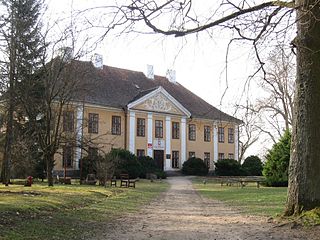
Smolajny is a village in the administrative district of Gmina Dobre Miasto, within Olsztyn County, Warmian-Masurian Voivodeship, in northern Poland. It lies on the Łyna River in the historical region of Warmia, approximately 5 kilometres (3 mi) north of Dobre Miasto and 28 km (17 mi) north of the regional capital Olsztyn.

Jonkowo is a village in Olsztyn County, Warmian-Masurian Voivodeship, in northern Poland. It is the seat of the gmina called Gmina Jonkowo. It lies approximately 14 km (9 mi) west of the regional capital Olsztyn. It is located in Warmia.

Klebark Wielki is a village in the administrative district of Gmina Purda, within Olsztyn County, Warmian-Masurian Voivodeship, in northern Poland. It lies approximately 8 kilometres (5 mi) north-west of Purda and 8 km (5 mi) south-east of the regional capital Olsztyn. It is located in Warmia.
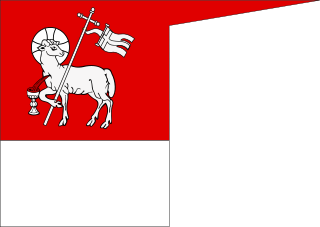
The Prince-Bishopric of Warmia was a semi-independent ecclesiastical state, ruled by the incumbent ordinary of the Warmia see and comprising one third of the then diocesan area. The Warmia see was a Prussian diocese under the jurisdiction of the Archbishopric of Riga that was a protectorate of the Monastic state of the Teutonic Knights (1243–1464) and a protectorate and part of the Kingdom of Poland—later part of the Polish–Lithuanian Commonwealth (1464–1772), confirmed by the Peace of Thorn in 1466. The other two thirds of the diocese were under the secular rule of the Teutonic Knights until 1525 and Ducal Prussia thereafter, both entities also being a protectorate and part of Poland from 1466.
